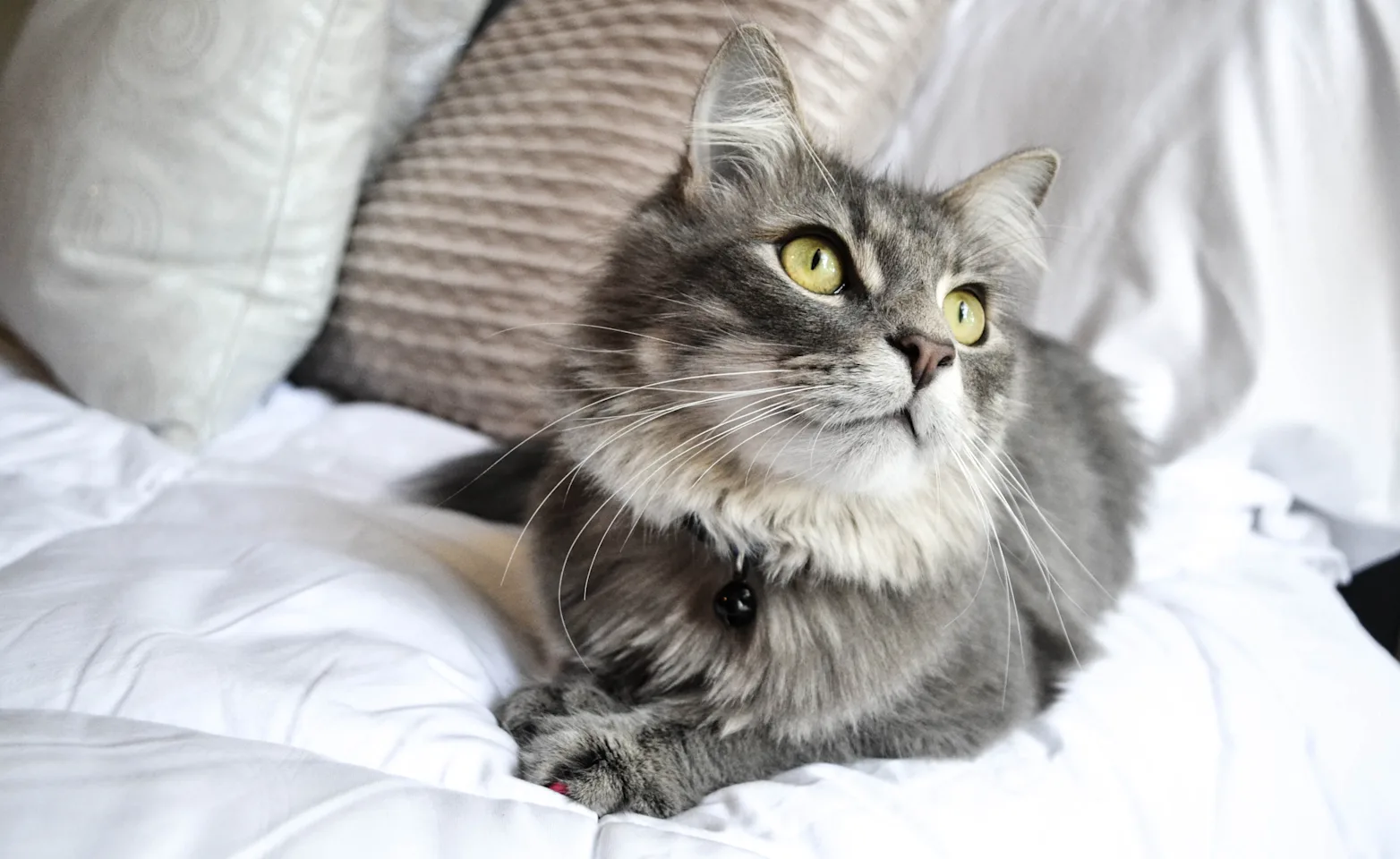Cat Thyroid Center
Feline Patients with hyperthyroidism and kidney disease
As cats age, just like humans, they experience a gradual loss of kidney function. They should be carefully evaluated for any signs of underlying early kidney disease, e.g. hypertension, small kidneys on radiographs, palpable changes in size or structure of kidneys, mineralization in the kidneys or hyposthenuria and hyperproteinuria. As the disease progresses, there are measurable changes in their blood levels of urea nitrogen and creatinine.
Early in renal failure, the kidneys start losing their ability to concentrate urine. This gradual process can be monitored by measuring the urine specific gravity with a refractometer. Measurements should be taken when the cat is not on a diuretic and before the administration of fluid therapy. A normal feline urine specific gravity should be greater than 1.035 mg/dL and can range to concentrations greater than 1.050. Aging alone can take its toll on the kidneys and they begin to fail, producing a more dilute urine. Thus the cat urinates more frequently and compensates by drinking more water. However, a low urine specific gravity can be caused from increased thirst secondary to hyperthyroidism and not from renal failure. Low specific gravity alone should not be used to rule out I-131 therapy.
We rely on the BUN (blood urea nitrogen), creatinine, urine analysis, kidney size, and blood pressure to evaluate and monitor feline kidney function. Urea is the end product of protein digestion and its concentration varies with the diet and with kidney function. Creatinine is produced at a fairly constant rate depending on muscle mass and renal function. As the cat’s kidneys begin to fail, they do not filter these metabolic byproducts as efficiently. Their concentration in the blood rises and the cat begins to drink more water.
Stage 1 Chronic Kidney Disease
Kidney disease usually goes undetected. No apparent symptoms. Usually caused by an insult to the kidney. No biochemical evidence. No azotemia.
Stage 2 Chronic Kidney Disease (Mild Azotemia)
Stage 2 kidney disease may have very subtle signs. These cats will have a creatinine level between 1.6-2.8 mg/dL. Azotemia does not preclude us from treating a patient, but we use a lower dose to try to prevent worsening the condition. Proper diet and fluid therapy remain the mainstays for renal disease. Click here for more information about feline kidney diets.
Stage 3 Chronic Kidney Disease
By definition, these cats are uremic with elevated BUN levels and Creatinine levels between 2.9-5.0 mg/dL. They are sometimes nauseated with vomiting or inappetance and/or lethargy.
Fluid therapy in the hospital or administered at home by the client at a frequency from once a week to every day has maintained many cats for years.
We feel the addition of essential fatty acids to the diet to reduce renal inflammation is beneficial and without any negative side effects. These are the omega-3 fatty acids.
Concurrent administration of ACE inhibitors has shown to be beneficial in some patients but is not something that we routinely recommend. When these drugs are used, the BUN and creatinine levels must be monitored closely.
Stage 4 Chronic Kidney Disease
These cats are in end-stage renal failure. They have Creatinine levels in excess of 5.0 mg/dL. Aggressive intravenous fluid therapy, antiemetics, and adequate caloric intake are essential.
Feeding any food at this stage is far more valuable than trying to encourage a less palatable, scientifically formulated diet. Patients in stage 4 chronic kidney disease would generally not be accepted for I-131 therapy.
Some clinicians do a Tapazole trial for a few weeks. Prescribe Tapazole at 5 mg divided b.i.d. and adjust the dose higher to reduce the thyroid hormone level to the euthyroid range, ideally between 1 and 2 mg/dL. At this time blood tests are done, including CBC, BUN, and Creatinine. The CBC should be normal and the BUN and Creatinine may be higher, but still be within normal limits. Thus if the kidney values remain stable, the cat will show a similar result when the euthyroid state is accomplished with radioactive iodine.
This is not a guarantee that the kidneys will remain healthy for a long time after the treatment, but it is a very good sign. On the other hand, if both blood tests quickly become abnormally high, e.g. BUN > 50 and Creatinine >5.0 mg/dL and these values continue to climb, this patient is not a good candidate for radioactive iodine. If the patient’s blood levels remain elevated but constant, then this patient would be an acceptable candidate based on all other factors being equal.
In addition to monitoring the Creatinine and Urea nitrogen levels, it is important to monitor blood pressure and urine protein/Creatinine levels.

Patients with Gallop Rhythm or Murmurs
We find patients with abnormal heart rhythms and murmurs due to the extremely high heart rates, sometimes exceeding 300 bpm. This tachycardia can be controlled with cardiotropic medications such as Atenolol until the radioactive iodine takes effect. Usually the heart medications can be discontinued within 3-4 weeks after treatment and the heart rate will be almost normal. Sometimes the murmurs improve or disappear, but not always.
FAQs and Explanation of Necessary Tests
Why and what is “clean” lab work?
When patients have been on anti-thyroid medication, supplements, or Hill’s y/d diet for more than 2 months, “clean” lab work is necessary to help accurately determine their treatment dosage.
Since the overactive nodule can continue to grow while on these treatments, the baseline T4 may change significantly. These changes can directly influence the amount of radioiodine given.
Dependent upon their current treatment, patients must discontinue for a certain timeframe prior to new testing.
Methimazole/Felimazole 10 days
Hills y/d diet 3 weeks
Thyroid supplements- please call our facility for guidance. Some require up to 6 weeks in order not to interfere with results of testing and treatment.
By getting a current thyroid value (while off treatment) we can more accurately dose the I-131 and achieve better treatment outcomes.
Why a reference lab vs in house testing?
An accurate and absolute value is critical to determine an accurate treatment dosage.
We have seen significant variations in T4 values between in house and reference labs.
In addition, “greater than” values make it impossible to treat a patient confidently. For example, a T4 of >8.0 may be 8.1, or 12, or 35. The actual value will help minimize the chances of treatment failure or permanent hypothyroidism after treatment. Of note -
Antech will report a T4 value up to 40 mcg/dL
Idexx will report a T4 value up to 24 mcg/dL (may add a T4 by RIA to obtain a value up to 40)
Zoetis will report a T4 values up to 15 mcg/dL (they will dilute further upon request)
When is a Free T4 (ED) warranted?
The T4 is equivocal (within the top quarter of the reference range)
The T4 is in the high end of the reference range or just above normal.
These patients may or may not be symptomatic.
A free T4 by equilibrium dialysis is strongly preferred, when measuring a fT4 is indicated.
These patients may also need to be retested in several weeks or months to confirm the diagnosis unless a thyroid nodule is palpable.
Why are radiographs recommended?
Radiographs are a non-invasive tool to screen for concerns not apparent on lab work. Most of our patients are seniors and may have concurrent medical issues. We routinely find masses and other abnormalities that may warrant a change in the treatment plan altogether. Occasionally masses or nodules are found in the chest that may or may not be associated with hyperthyroidism. This can also affect the dosage.
Radiographs can give the client more information on their pet’s health so that they can make an informed decision on whether they would like to move forward with treatment. Many times, we move forward and cure the hyperthyroidism while the owners are aware that other concerns may need addressed.
Although radiographs are highly recommended, the client may decline them. We will have them sign a refusal document if they choose to decline them.
Renal Disease Screening
As we treat primarily senior and geriatric cats, many of our patients have some stage of renal disease.
Hyperthyroidism makes IRIS staging difficult as active hyperthyroidism can mask the extent of renal dysfunction. The more information on renal function we have, the better we can prepare owners for what to expect as far as renal disease management post treatment.
However, there is no way to predict the development of renal disease with 100% accuracy.
Typical pre-treatment renal evaluation would include BUN, Creatinine, SDMA, and urinalysis.
Post-treatment labwork is recommended ONE and THREE months after I-131 treatment – this testing should include at a minimum the weight, T4, BUN, Creatinine, SDMA, and urinalysis.
Consider Blood Pressure, CBC, full chemistry, and often a cTSH in addition.
Thyroid Nodules
If you are able to palpate a thyroid nodule, please include this information in the medical notes!
A size comparison is also beneficial. (ex. pea sized, 6mm, …). This information helps “fine tune” dosing. We know this can be tricky, even on the best of patients!
Each Patient is Unique
While we have guidelines for preadmission, each patient is unique!
Our goal is to make the process as easy as possible.
When your patient doesn’t “fit the mold,” or if you have any questions, please call or email us!
We are happy to help!
Professional Discount to Veterinarians
We offer a professional discount to licensed veterinarians, Veterinary staff, and qualifying feline rescue organizations. Please call for information.
If you have questions regarding the treatment of Feline Hyperthyroidism and how we can help your cat, visit the contacts page and fill out the Inquiry Form and a representative will contact you.
